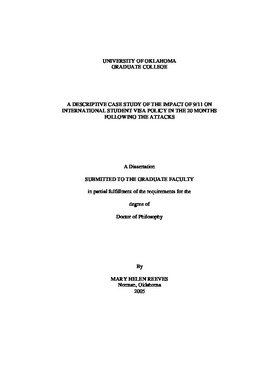| dc.contributor.advisor | Owens, J. Thomas, | en_US |
| dc.contributor.advisor | Smith, Joan K., | en_US |
| dc.contributor.author | Reeves, Mary Helen. | en_US |
| dc.date.accessioned | 2013-08-16T12:19:54Z | |
| dc.date.available | 2013-08-16T12:19:54Z | |
| dc.date.issued | 2005 | en_US |
| dc.identifier.uri | https://hdl.handle.net/11244/917 | |
| dc.description.abstract | International students in the U.S. have consistently been treated in public policy as educational diplomatic and economic assets. In the year before 9/11, a national policy endorsing international education, including support for international student flows to the U.S., received presidential and Congressional support. After 9/11, however, the system by which international students obtain visas, enter and stay in the U.S. was identified as a national security problem. Within two months, legislative action mandated tracking of international students though the new Student and Exchange Visitor Information System (SEVIS). This was followed in the next 18 months by a cascade of other legislation, regulations and rules. These buffeted international students, the advocacy community which serves the international education exchange arena, and the administrators who work on a daily basis with international students on U.S. campuses. This case study describes the impact in three arenas: (1) The flow of policy and regulation was rapid, dense with procedures and deadlines, and mandated implementation of largely unpiloted programs and events. (2) The advocacy community responded by accepting SEVIS and some visa reforms in the name of national security, despite previous opposition. They continued to work to shape legislation, SEVIS features and visa policies; to provide extensive support for practitioners struggling to implement the new policies and regulations; and to collect data on the impact of the new policies on international students and scholars. (3) During this chaotic period, administrators in the field, as reported in in-person interviews, experienced deep changes in the work of their offices, with implementation of SEVIS the most demanding event; they also worked to protect and support their students and to represent this population positively to their campuses and the media. They reported a variety of positive outcomes as well as difficulties. Several policy process constructs inform the results of the descriptive data, particularly those related to agenda shift following a focusing event. Other policy constructs which deepen understanding of the case include the characteristics of punctuated equilibrium, shifts in the tone of a policy's image, and use of causal stories to affect an issue's position on the governmental agenda. | en_US |
| dc.format.extent | x, 225 leaves ; | en_US |
| dc.subject | Education, Bilingual and Multicultural. | en_US |
| dc.subject | Student passports United States. | en_US |
| dc.subject | Education, Higher. | en_US |
| dc.subject | Students, Foreign Legal status, laws, etc. United States. | en_US |
| dc.subject | Education, Administration. | en_US |
| dc.subject | September 11 Terrorist Attacks, 2001. | en_US |
| dc.title | A descriptive case study of the impact of 9/11 on international student visa policy in the 20 months following the attacks. | en_US |
| dc.type | Thesis | en_US |
| dc.thesis.degree | Ph.D. | en_US |
| dc.thesis.degreeDiscipline | Department of Educational Leadership and Policy Studies | en_US |
| dc.note | Advisers: J. Thomas Owens; Joan K. Smith. | en_US |
| dc.note | Source: Dissertation Abstracts International, Volume: 66-08, Section: A, page: 2799. | en_US |
| ou.identifier | (UMI)AAI3187222 | en_US |
| ou.group | Jeannine Rainbolt College of Education::Department of Educational Leadership and Policy Studies | |
